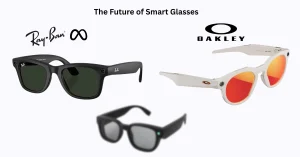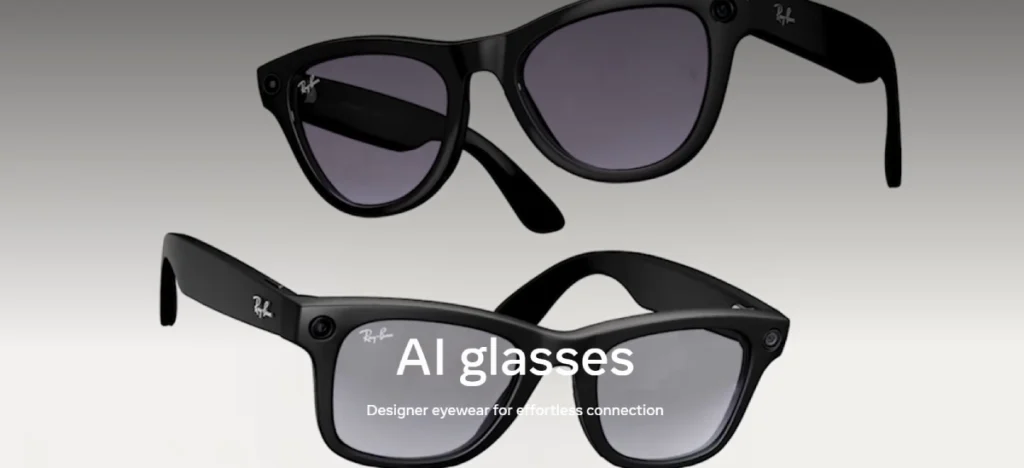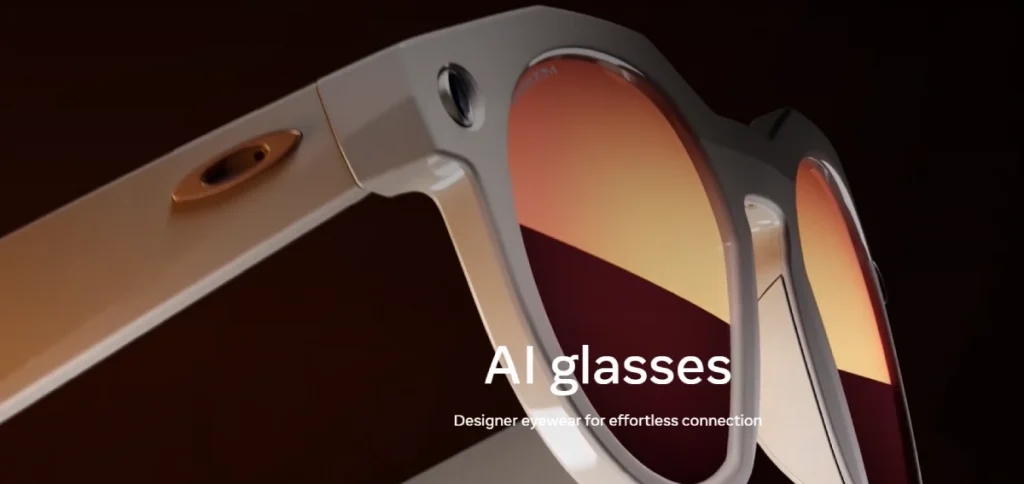AI Smart Glasses: Meta Ray-Ban & Oakley's New AI-Powered Eyewear in 2025

The artificial intelligence smart glasses market is experiencing explosive growth in 2025, with industry projections showing remarkable momentum that positions these devices as the next major consumer technology breakthrough. Global sales reached approximately 1.52 million pairs in 2024, but analysts predict this number will skyrocket to 90 million pairs by 2030. This represents an extraordinary compound annual growth rate that demonstrates the transformative potential of AI-powered wearable technology.
Meta has emerged as the dominant force in this rapidly evolving landscape, building on the success of their Ray-Ban collaboration while expanding into new market segments. The company’s strategic partnership with EssilorLuxottica has proven crucial in overcoming the design challenges that plagued earlier smart glasses attempts. Now, with the introduction of the Oakley Meta HSTN glasses alongside their established Ray-Ban line, Meta is positioning itself to capture both lifestyle consumers and performance-oriented athletes.
The AI Revolution in Smart Glasses Technology

Artificial intelligence has transformed smart glasses from simple recording devices into sophisticated computing platforms capable of understanding and responding to the world around us. The latest generation of AI smart glasses leverage advanced machine learning algorithms to process information from multiple sources simultaneously, including cameras, microphones, and environmental sensors.
Multimodal AI capabilities represent the most significant breakthrough in this technology evolution. Modern smart glasses can now analyze visual scenes while simultaneously processing spoken commands, creating a seamless interaction between the digital and physical worlds. This advancement enables users to simply look at objects and ask questions about them, receiving instant, contextually relevant information without needing to interact with smartphones or other devices.
The market is experiencing unprecedented innovation momentum, with over 30 new AI smart glasses models launched in the past year alone. Technology improvements in 5G connectivity, miniaturized processors, and enhanced battery performance have made sustained AI operations feasible in lightweight, fashionable frames. These technological convergences have created the perfect conditions for mainstream adoption.
Meta Ray-Ban Smart Glasses: AI Features Deep Dive

Meta’s Ray-Ban smart glasses have established themselves as the benchmark for consumer AI wearables through continuous innovation and feature expansion. The current generation integrates Meta’s advanced AI assistant, powered by the latest iteration of their language models, enabling sophisticated natural language processing and contextual understanding that feels remarkably human-like.
Advanced AI Assistant Capabilities
The Meta AI assistant represents the centerpiece of the Ray-Ban smart glasses experience. Built on Meta’s latest language models, the system can process both visual and auditory inputs simultaneously, allowing users to ask questions about their surroundings and receive detailed, contextually appropriate responses. The AI maintains conversational context across multiple interactions, eliminating the rigid command structures that characterized earlier voice-controlled devices.
Recent updates have significantly expanded the AI’s knowledge base with real-time information access, addressing previous limitations where the assistant could only provide static information. Users can now inquire about current events, weather conditions, traffic updates, and live sports scores directly through their glasses, transforming the device into a comprehensive information portal that rivals traditional smartphones.
Multimodal Processing Excellence
The multimodal capabilities of Ray-Ban Meta glasses represent a quantum leap in wearable technology sophistication. The integrated 12-megapixel camera works seamlessly with an array of five precision microphones to capture and analyze both visual and auditory information from the user’s environment simultaneously.
This multimodal processing enables contextual assistance based on what users are seeing and hearing in real-time. Users can activate visual analysis by asking questions about their surroundings, prompting the AI to examine the camera feed and provide detailed descriptions, identify objects, or offer relevant information about landmarks, products, or documents within view. The system can also scan QR codes, read text aloud, and analyze nutritional information from food packaging.
Real-Time Translation and Memory Integration
One of the most impressive capabilities introduced in 2025 is the real-time translation feature. The glasses can translate conversations in real-time between English, Spanish, French, and Italian, making them invaluable tools for international travel and cross-cultural communication. The translation system operates both online and offline through downloadable language packs, ensuring functionality even in areas with limited internet connectivity.
The AI assistant also features enhanced memory capabilities that create contextual reminders based on visual cues in the environment. Users can look at objects and create location-based or item-specific reminders that the system will recall at appropriate times. This feature extends across various objects and locations, creating a personalized memory system that integrates seamlessly with daily routines.
Natural Conversation Flow
Recent improvements to the Ray-Ban Meta glasses have revolutionized voice command recognition and natural language processing. The system now supports more conversational interactions, allowing users to engage in follow-up questions and multi-turn conversations with the AI assistant without repeating wake words or using specific command phrases.
Voice recognition improvements include advanced noise cancellation through the five-microphone array, enabling accurate recognition even in challenging acoustic environments. The system intelligently distinguishes between direct commands and ambient conversation, reducing false activations while maintaining responsiveness when needed.
Ecosystem Integration
The Ray-Ban Meta glasses integrate seamlessly with Meta’s comprehensive ecosystem of platforms and services. Users can directly share photos and videos to Instagram and Facebook, stream content from various music platforms, and manage messaging through voice commands. This ecosystem integration extends to Meta’s virtual reality platforms, creating a unified experience across multiple devices and interfaces.
Oakley Meta HSTN: The Athletic AI Eyewear

The Oakley Meta HSTN glasses represent Meta’s strategic expansion into the performance wearables market, combining athletic-focused design with advanced artificial intelligence capabilities. Launched in June 2025, these glasses target athletes and active users who require enhanced durability, extended battery life, and specialized AI features designed specifically for physical activities.
Launch Strategy and Positioning
The Oakley Meta HSTN launches with a premium limited-edition model priced at $499, featuring distinctive gold accents and 24K Prizm Polar lenses. This premium positioning reflects the high-performance nature of the product, with broader collection models starting at $399. The product debuts in 15 countries, with planned expansion to additional markets throughout 2025.
The marketing strategy leverages high-profile endorsements from elite Team Oakley athletes, including World Cup winner Kylian Mbappé, three-time Super Bowl MVP Patrick Mahomes, and surfing champion Gabriel Medina. This athletic marketing approach positions the glasses as professional-grade equipment rather than consumer electronics, appealing to serious athletes and sports enthusiasts.
Performance-Focused AI Applications
The Oakley Meta HSTN glasses feature specialized AI applications designed specifically for athletic performance and outdoor activities. The integrated Meta AI assistant provides contextual information relevant to sports and fitness activities, including real-time environmental data that can affect performance, such as wind conditions for golf or weather factors for outdoor training.
The AI system includes enhanced environmental awareness capabilities, allowing athletes to receive coaching tips, technique analysis, and performance feedback through natural voice interactions. The AI can analyze movement patterns and provide real-time feedback for form correction and injury prevention, making it a valuable training companion.
Enhanced Video Capabilities
A significant upgrade in the Oakley Meta HSTN is the advanced camera system, featuring 12-megapixel photography and 3K video recording capabilities. This higher resolution enables detailed content capture for training analysis, social media sharing, and professional documentation of athletic achievements.
The enhanced AI processing capabilities leverage this superior visual input to provide more accurate scene analysis and object recognition. Athletes can record training sessions and ask the AI assistant to analyze technique, identify areas for improvement, or track progress over time. The system can recognize sports equipment, playing surfaces, and training environments to provide contextually relevant coaching advice.
Superior Battery Performance
The Oakley Meta HSTN addresses one of the primary limitations of wearable technology with significantly improved battery performance. The glasses offer up to 8 hours of typical use, representing a substantial improvement over previous generation devices. The standby mode extends to 19 hours, with the charging case providing an additional 40-48 hours of charging capacity.
Fast charging capabilities allow the glasses to reach 50% battery capacity in just 20 minutes, with 85% charge achievable in 45 minutes. This rapid charging feature ensures minimal downtime during training schedules or competitive events, making the glasses practical for extended use.
Athletic Durability Features
Durability enhancements include IPX4 water resistance rating, protecting against sweat, rain, and splashes during intense physical activity. The frame design incorporates Oakley’s proven HSTN styling, known for secure fit and stability during vigorous movement. These durability features make the glasses suitable for outdoor sports, water activities, and challenging environmental conditions.
Technology Comparison: Ray-Ban vs Oakley Meta
The comparison between Ray-Ban Meta and Oakley Meta HSTN reveals distinct positioning strategies targeting different user segments while sharing core AI capabilities.
AI Assistant Features: Both models feature the same advanced Meta AI assistant with multimodal processing capabilities. However, the Oakley version includes specialized sports-focused features like environmental analysis and performance coaching, while Ray-Ban emphasizes lifestyle integration and translation capabilities.
Camera and Recording: Ray-Ban Meta offers 12MP photos and 1080p video recording, while Oakley Meta HSTN provides enhanced 3K video recording capabilities. The superior video quality in Oakley models supports detailed training analysis and professional content creation.
Battery Life: This represents the most significant difference between the models. Ray-Ban Meta provides approximately 4 hours of typical use, while Oakley Meta HSTN offers up to 8 hours, making it more suitable for extended activities and professional use.
Durability: Ray-Ban Meta glasses are designed for everyday consumer use, while Oakley Meta HSTN features IPX4 water resistance and athletic-grade frame construction for demanding physical activities.
Pricing Strategy: Ray-Ban Meta starts at $329, positioning it as a premium lifestyle accessory. Oakley Meta HSTN begins at $399, with limited editions reaching $499, reflecting its professional athletic positioning.
Target Demographics: Ray-Ban targets general consumers, tech enthusiasts, and lifestyle users seeking fashionable technology integration. Oakley focuses on athletes, fitness enthusiasts, and outdoor adventurers requiring specialized performance features.
Future of AI in Wearable Technology

The evolution of AI smart glasses represents the beginning of a broader transformation in wearable artificial intelligence. Industry analysts predict the global smart glasses market will continue its explosive growth trajectory, driven by continuous improvements in AI processing power, battery technology, and miniaturized components.
Emerging Technology Trends
Several key developments are shaping the future of smart glasses artificial intelligence. Generative AI integration will enable more sophisticated conversational interfaces, allowing glasses to serve as personal coaches, tutors, and creative assistants. The development of personalized AI profiles will create customized experiences that predict user needs and provide proactive recommendations.
Advanced sensor integration will expand beyond cameras and microphones to include comprehensive biometric monitoring, environmental sensors, and gesture recognition capabilities. These sensors will enable AI glasses to monitor health metrics like heart rate, stress levels, and sleep quality while providing real-time feedback and health optimization suggestions.
Platform Integration Evolution
The future of AI assistant glasses lies in seamless integration across multiple AI platforms and ecosystems. Current ecosystem integration demonstrates this trend, but future developments will likely include connections to productivity platforms, smart home systems, and enterprise software solutions.
Cross-platform AI collaboration will enable glasses to serve as universal interfaces for multiple AI assistants, allowing users to access different AI services through a single device. This integration will require sophisticated AI orchestration to manage multiple assistant personalities and capabilities seamlessly.
Privacy and Security Considerations
The proliferation of multimodal AI wearables raises important privacy and data security considerations that will influence future development. AI glasses continuously collect visual, audio, and biometric data, creating comprehensive profiles of user behavior, preferences, and personal information.
Future development will emphasize data minimization principles, with AI glasses designed to process information locally whenever possible and collect only essential data for cloud-based processing. Advanced encryption and secure authentication methods will protect user data during transmission and storage.
Conclusion

The AI smart glasses revolution of 2025 represents a fundamental transformation in how we interact with technology, information, and our environment through sophisticated artificial intelligence integration. Meta’s Ray-Ban smart glasses have established the foundation for mainstream adoption with their seamless AI assistant capabilities, real-time translation features, and ecosystem integration that makes advanced AI accessible to everyday users.
The newly launched Oakley Meta HSTN glasses expand this vision into the athletic market, offering enhanced battery life, superior video recording capabilities, and sports-focused AI applications that cater to performance-oriented users. Both products demonstrate the maturation of multimodal AI wearables that can simultaneously process visual, audio, and contextual information to provide intelligent assistance without disrupting natural activities.
The key differentiators between these products lie in their target markets and specialized features, with Ray-Ban focusing on lifestyle integration and social connectivity, while Oakley emphasizes athletic performance and durability. This strategic segmentation allows Meta to capture multiple market segments while expanding overall adoption of AI smart glasses technology.
The future of smart glasses artificial intelligence promises even more sophisticated capabilities through continued generative AI integration, expanded sensor arrays, and seamless platform connectivity. These developments will make AI glasses indispensable tools for productivity, health monitoring, and augmented reality experiences that enhance human capabilities rather than simply providing additional features.
For consumers considering entry into the AI wearables space, both Meta Ray-Ban and Oakley Meta HSTN glasses offer compelling access points into this revolutionary technology category. The choice between models depends on individual lifestyle needs, activity levels, and specific use case requirements. The ongoing development of next-generation models with integrated displays will further accelerate adoption and expand capabilities throughout 2025 and beyond, solidifying AI smart glasses as essential technology for the future.
